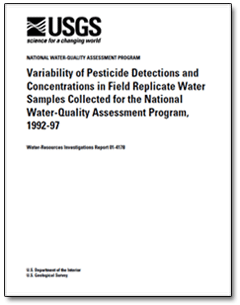Water Resources Investigations 01-4178
By Jeffrey D. Martin

IntroductionThe U.S. Geological Survey (USGS) began implementing the National Water-Quality Assessment (NAWQA) Program in 1991. The goals of the NAWQA Program are to describe current water-quality conditions and trends in the Nation’s streams and ground water and to understand the natural characteristics and human influences that affect water quality (Hirsch and others, 1988, p.1). The NAWQA Program is assessing the water quality in more than 50 of the Nation’s largest river basins and aquifers. These river basins and aquifers, known as NAWQA Study Units, account for about half the land area of the conterminous United States and approximately 60 to 70 percent of the Nation’s water use and population served by public water supplies (Leahy and Wilber, 1991, p.1). The Study-Unit investigations are divided into three groups that assess water quality on a rotational schedule. Investigations of water quality in 20 Study Units began in 1991. Study-Unit investigations and national synthesis are the major design features of the NAWQA Program that allow water-quality information collected and interpreted locally to be integrated into a national description of water quality (Gilliom and others, 1995, p. 2–3). One of the major tasks of the NAWQA Program is to assess the occurrence and distribution of pesticides in surface and ground water. The goal for Study-Unit investigations is to identify pesticides in the water resources of the Study Unit and to characterize and explain the geographic and seasonal distributions of pesticides (Gilliom and others, 1995, p.4–6). The goal for national synthesis is to characterize, compare, and explain the geographic and seasonal distributions of pesticides among the broad range of land-use and hydrologic settings in the United States. |
For additional information contact: Part or all of this report is presented in Portable Document Format (PDF); the latest version of Adobe Reader or similar software is required to view it. Download the latest version of Adobe Reader, free of charge. |
Suggested citation:
Martin , J.D., 2001, Variability of pesticide detections and concentrations in field replicate water samples collected for the National Water-Quality Assessment Program, 1992-97: U.S. Geological Survey Water Resources Investigations Report 01-4178.